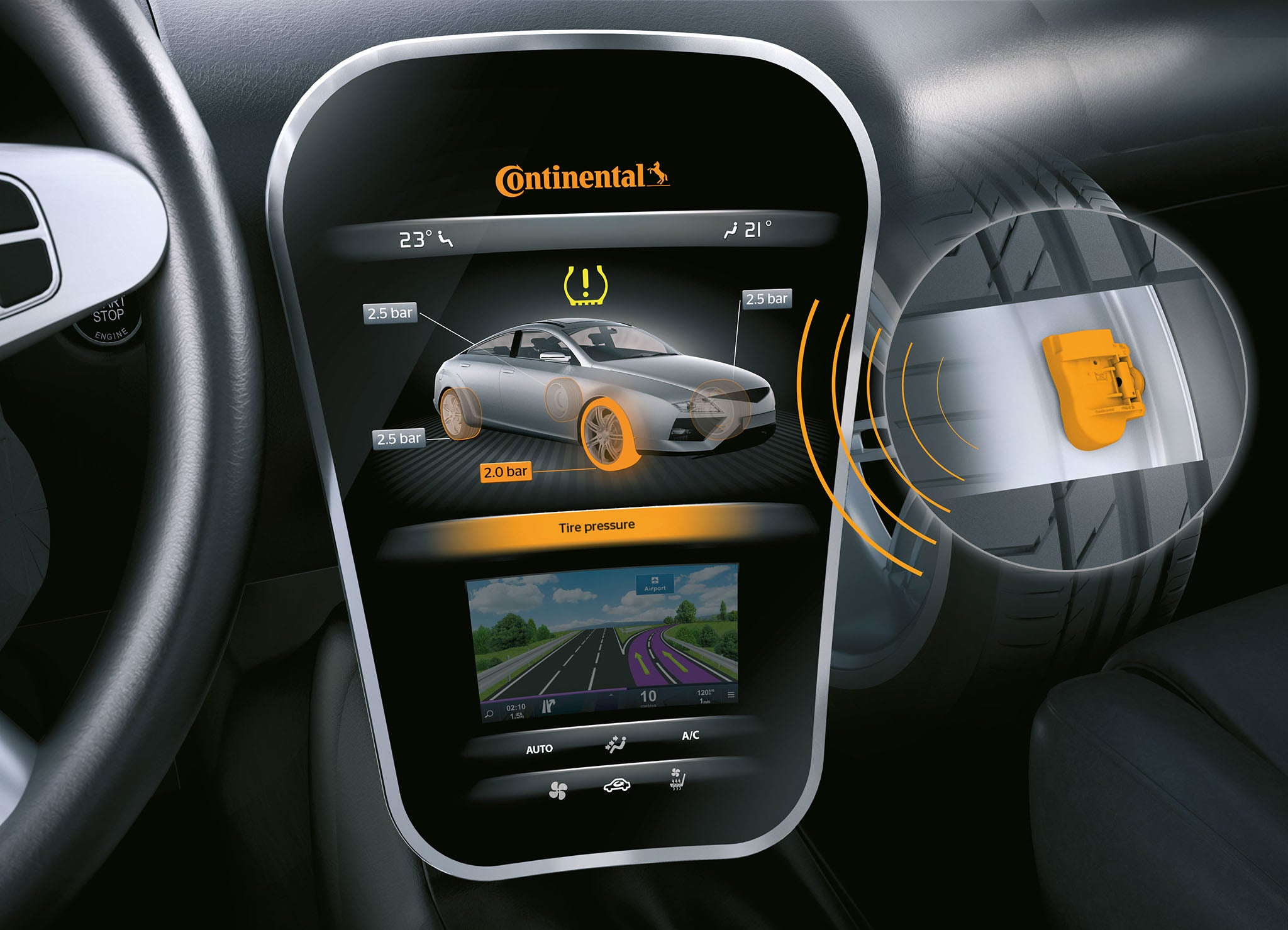
# Tyre Care and Maintenance
Tyre Pressure Monitoring System (TPMS)
Continuously monitors tyre pressure in real-time

Driving safety and comfort are directly related to the long-term condition of your tyres. If they're in poor condition, then it's only a matter of time before disaster strikes. Approximately 40 per cent of all incidents of unexpected tyre failure, for example, are caused by under inflated tyres.
To address this problem, Continental has developed a tyre pressure monitoring system (TPMS) that works with wheel sensors and brake systems to alert the driver of low tyre pressure levels via a car dashboard warning light.
The TPMS continuously and reliably monitors the inflation pressure in real-time. In the event of pressure loss below a safe threshold, it immediately alerts the driver to take action. When used correctly, the TPMS can enhance driving safety by eliminating a frequent cause of accidents.
Sounds pretty impressive, right? Well, that's not all. Another benefit of this invaluable safety feature is that it reduces your car's fuel consumption and CO₂ emissions.
If a car's tyres are underinflated by only 0.3 bar, for example, the vehicle consumes 1.5 per cent more fuel – and produces a correspondingly higher amount of CO₂ emissions.
There are many more advantages to a TPMS, including:
- Optimising tyre performance characteristics, from braking performance to aquaplaning protection;
- Extended tyre life;
- Speed-related warning signal;
- Systems built with modular architecture for scalable functionality;
- Compatible with a complete spectrum of Continental mechanical solutions.
State-of-the-art direct measurements with TPMS
Let's take a closer look at the inner workings of a tyre pressure monitoring system. How does it work?
Readings are taken directly from the tyre. Battery powered sensors mounted on the rim and integrated into the valve measure the tyre pressure. This data is coded and transmitted in a high-frequency signal to a receiver. Dedicated software in the control device processes the information and displays it on the dashboard of the vehicle.
In effect, thanks to these dedicated sensors, the driver now has complete oversight of tyre pressure changes. And most importantly, they're warned before a critical situation arises.
TPMS software is so sophisticated that, after evaluating the collected data, it can calculate the rate of pressure leakage.
Additional software functions are standardised warnings when approaching specific limits, an ongoing comparison of tyre temperature, automatic tyre identification, and checks on spare tyres.
TPMS can even distinguish whether the vehicle is moving or standing still, and adjusts the frequency of the sensors accordingly.
When a vehicle is moving, for example, tyre pressure and tyre temperature are monitored every few seconds, and TPMS delivers the readings continuously.
If the vehicle is standing still, however, the TPMS takes measurements between longer intervals. The readings are only transmitted after a pressure change has been detected.
Statutory regulations in Europe for TPMS
The European Commission has passed a law that requires integrated tyre pressure monitoring systems on all new cars manufactured since 2014.
Many vehicles already include TPMS as standard equipment. These systems can also make their data available to other vehicle systems, e.g. the braking system.
However, even if your vehicle does come equipped with a TPMS, it doesn't mean you should stop entirely conducting a manual tyre pressure check now and then. Continental recommends checking the tyre pressure once every two to four weeks as a routine precautionary measure.
Related content
-
 2022/09/07Tyre pressureCar safety is significantly upgraded with an integrated TPMS. Learn all about integrated tyre-pressure monitoring systems and how they work.Read more
2022/09/07Tyre pressureCar safety is significantly upgraded with an integrated TPMS. Learn all about integrated tyre-pressure monitoring systems and how they work.Read more -
 2022/09/07Nitrogen in tyresDid you know you can inflate tyres with nitrogen instead of with air? Learn about the pros and cons of having nitrogen-filled tyres on your wheels.Read more
2022/09/07Nitrogen in tyresDid you know you can inflate tyres with nitrogen instead of with air? Learn about the pros and cons of having nitrogen-filled tyres on your wheels.Read more -
 2022/09/07Tread depthThe tyre tread grips the road and wears down as you drive. To ensure your safety, measure the tread depth as part of your regular vehicle maintenance.Read more
2022/09/07Tread depthThe tyre tread grips the road and wears down as you drive. To ensure your safety, measure the tread depth as part of your regular vehicle maintenance.Read more